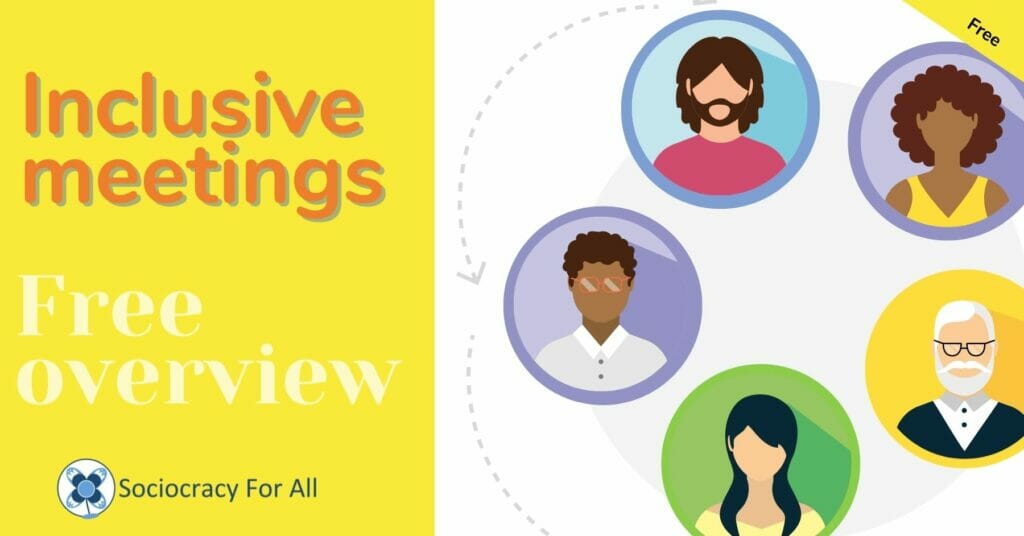
Table of Contents
Do you remember being confused about the purpose of a meeting? Or perhaps the conversation kept wandering without any concrete decisions? Good meeting facilitation is essential to keeping meetings on track. Facilitation means guiding the meeting process, and making sure the meeting accomplishes shared goals. Poorly facilitated meetings can be a waste of everyone’s time. Our job is teaching a form of governance and decision-making called sociocracy. Sociocracy comes with specific tools and practices for meetings that can also be applied in other contexts. We’re here to help you improve meetings with these tried and true facilitation tips. The next time you facilitate a meeting, you’ll be confident and ready.
Tip 1: Clarify meeting roles
When you meet, it’s often helpful to have at least a designated note-taker and a facilitator. Read more about these process roles here. It’s best if the facilitator is selected in advance so they can get familiar with the agenda. You can also ask for volunteers at the beginning of a meeting if you need to. You can select long-term facilitators in a meeting as a decision item on the agenda. In sociocracy, there is a specific selection process. First, the duties and qualifications of a role are clarified. Then people are selected into roles for a limited time based on their qualifications.
Tip 2: Start with a clearly defined agenda
In order to effectively facilitate a meeting, you need a clearly prepared agenda with allotted times for each topic. Your facilitator should be familiar with the agenda ahead of time. Organize the agenda with the most important topics first so that you are sure to cover them.
Make the goal of each topic clear. Agenda items can fall into three categories:
- Report: Is this a report, where the goal is for everyone to understand something?
- Exploration: Is it an exploration, where the goal is to brainstorm or give feedback on ideas?
- Decision: Or is it a decision that needs to be made?
Read more about these distinctions here. If you want help getting started with an agenda, we also provide tried-and-true free meeting agenda templates here.
Tip 3: Stick to the meeting time and topics
Meetings are better when everyone’s time is respected. To be an effective facilitator, you need to keep an eye on the clock and wrap things up in a timely manner. Let the group know when time is running out for a topic. If you need to extend the time for a topic, make sure to ask the group for consent before going over time. Make a plan of what to do with topics that get skipped. A good practice is keeping a shared “backlog,” or list of future agenda topics. This ensures that both new topic ideas as well as skipped agenda items are covered in a future meeting and that nothing falls between the cracks.
Tip 4: Make it clear whose turn it is to speak
The facilitator’s role is to keep the meeting going, and also to indicate when it’s time to speak. For a meeting with more than 2 or 3 people, you may need a method of turn-taking rather than going with the “natural flow.” Some common methods of turn-taking in meetings include:
- Popcorn: People speak up as they feel moved, but only speak once.
- Taking turns in a circle: The facilitator prompts each person to speak in turn.
- Raised hands: Each person raises their hands and is called on by the facilitator.
- Stack: The facilitator keeps a visible written list of whose turn it is to speak next so that the order is clear.
In sociocracy, we recommend taking turns in a circle, which we call “rounds.” As long as it’s clear what speaking style you are using, the meeting will go much more smoothly. Another key sign of effective facilitation is that everyone speaks for roughly the same amount of time. The next time you facilitate a meeting, try out these methods of turn-taking.
Tip 5: Ask the group for help when you feel stuck
It happens to every facilitator- something unexpected happens and you don’t know what to do next. We have a 5-Minute Meeting First Aid Kit for these moments. An easy first step is to ask the group for help.
Take turns in a circle with the prompt, “What should we do now?”
Try to synthesize the group’s wisdom and make a proposal. “Is it OK if we try out X for the rest of the meeting?”
Tip 6: End the meeting with an evaluation
To continually make your meetings better, you need feedback. Ending with a meeting evaluation helps you adjust your facilitation to the group.
Ask: “What worked well? What could we do better next time?” When planning your next meeting, make sure to use the feedback and make changes.
There you have it! Try out these tips the next time you facilitate a meeting. Practice will make you an even better facilitator.
You can also check out our upcoming workshops on meeting facilitation below.






Leave a Reply
You must be logged in to post a comment.